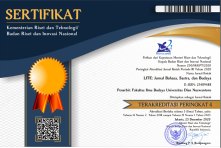The Conflict Between Life and Death Instinct in The Scarlet Letter by Nathaniel Hawthorne
Abstract
Keywords
Full Text:
PDFReferences
Abrams, M. H., & Harpham, G. G. (2012). Abrams, Meyer Howard; Harpham, Geoffrey Galt A glossary of literary terms.pdf (11th ed.). Wadswoth Cengage Learning.
Akhtar, S., & O’Neil, M. K. (2011). On Freud’s “Beyond the Pleasure Principle. Karnac.
Athanasiadou, A. (2020). Intensification via Figurative Language. In A. Baichi (Ed.), Figurative Meaning Construction in Thought and Language. Amsterdam. John Benjamins Publishing Company.
Colston, H. L. (2015). Using Figurative Language. Cambridge University Press.
DiYannni, R. (2000). Literature: Approaches to Fiction, Poetry, and Drama. McGraw Hill.
Ejupi, V., Siljanovska, L., & Iseni, A. (2014). the Struggle of Eros Against Thanatos in the Novel " Lady Chatterley ` S. European Scientific Journal, 10(11), 297–309. https://www.researchgate.net/publication/262014327_THE_STRUGGLE_OF_EROS_AGAINST_THANATOS_IN_THE_NOVEL_LADYCHATTERLES_LOVER_BY
Endraswara, S. (2008). Metodologi Penelitian Sastra. Media Pressindo.
Fadlilah, L. (2017). FIGURATIVE LANGUAGE IN THE SCARLET LETTER. 4(1), 34–38. https://e-journal.undikma.ac.id/index.php/joelt/article/view/2438/1722
Gibbs, R. W. (1998). The fight over metaphor in Thought and Language. In A. N. Katz, C. Cacciari, R. W. Gibbs, & M. Turner (Eds.), Figurative Language and Thought. Oxford University Press.
Hawthorne, N. (1959). The Scarlet Letter. New American Library.
Hilgard, E. R., Atkinson, R. L., Hoeksema, S. N., Smith, E. E., & Fredrickson, B. L. (1975). Introduction to Psychology. Harcourt Brace Jovanovich.
Ibáñez, F. J. R. de M. (2020). Figurative language: Relations and constraints. In J. Barnden & A. Gargett (Eds.), Producing Figurative Expression: Theoretical, experimental and practical perspectives. John Benjamins Publishing Company.
Kli, M. (2018). Eros and thanatos: A nondualistic interpretation: The dynamic of drives in personal and civilizational development from freud to marcuse. Psychoanalytic Review, 105(1), 67–89. https://doi.org/10.1521/prev.2018.105.1.67
Listyowati, R., & Hanna, I. D. (2020). An Analysis on Adultery in Hawthorne’s The Scarlet Letter. International Journal of English Education and Linguistics (IJoEEL), 2(2), 11–20. https://doi.org/10.33650/ijoeel.v2i2.1435
Liu, H. (2021). Cultural Communication and Socialization THE DUALITY OF HESTER PRYNNE ’ S IMAGE?: SUBVERSION AND SUBMISSION. 2(1), 9–12. https://doi.org/10.26480/cssj.01.2021.09.12
Muthari, A. H. H. (2014). Hermeneutika Sastra Barat dan Timur. Sadra Press.
Singh, D. M. S. X. P. (2019). The Interplay between Eros and Thanatos in Julian Barnes’ The Sense of an Ending. History Research Journal, 5(4), 222–226. https://doi.org/10.26643/hrj.v5i4.7608
Zheng, D. (2017). An Analysis of Symbolism in The Scarlet Letter. 142(Icelaic), 378–381. https://doi.org/10.2991/icelaic-17.2017.84
DOI: https://doi.org/10.33633/lite.v18i1.6096
Article Metrics
Abstract view : 222 timesPDF - 230 times
Refbacks
- There are currently no refbacks.
Copyright (c) 2022 Albertine Minderop, Syarif Hidayat
ISSN Online: 2548-9588
This work is licensed under a Creative Commons Attribution-ShareAlike 4.0 International License.
This journal is published by Universitas Dian Nuswantoro, Semarang, Indonesia.
Indexing & Archiving:
IN COLLABORATION WITH:
Indonesian Pragmatics Association
Konsorsium Program Studi Jepang Indonesia
Center for Foreign Language Training
Asosiasi Studi Pendidikan Bahasa Jepang Indonesia







































